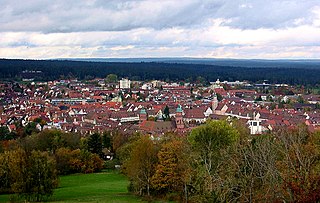
Freudenstadt is a town in Baden-Württemberg in southern Germany. It is the capital of the district Freudenstadt. The closest population centres are Offenburg to the west and Tübingen to the east.

The Kinzig is a river in southwestern Germany, a right tributary of the Rhine.

Schiltach is a town in the district of Rottweil, in Baden-Württemberg, Germany. It is situated in the eastern Black Forest, on the river Kinzig, 20 km south of Freudenstadt.

Albtal-Verkehrs-Gesellschaft is a railway company owned by the city of Karlsruhe that operates rail and bus services in the Karlsruhe area, southwest Germany. It is both an train operating company, as well as an infrastructure operator.
The Baden Black Forest Railway is a twin-track, electrified railway line in Baden-Württemberg, Germany, running in a NW-SE direction to link Offenburg on the Rhine Valley Railway (Rheintalbahn) with Singen on the High Rhine Railway (Hochrheinbahn). Passing directly across the Black Forest, through spectacular scenery, the route is 150 km long, ascends 650 metres from lowest to highest elevation, and passes through 39 tunnels and over 2 viaducts. It is still the only true mountain railway in Germany to be built with two tracks, and is the most important railway line in the Black Forest. It was built between 1863 and 1873, utilizing plans drawn up by Robert Gerwig.

The Dill Railway is a 73 km-long double-track electrified railway line, which runs from Gießen in Hesse to Siegen in North Rhine-Westphalia. The line is mainly worked by regional trains, including diesel multiples of the DreiLänderBahn, except for the IC 34, which runs between Frankfurt and Siegen, stopping in Dillenburg. The southern section between Haiger and Gießen was built by the Cologne-Minden Railway Company in 1862 as part of its line from Deutz and is one of the oldest railways in Germany. The section from Haiger to Siegen was opened in 1915 by the Prussian state railways.
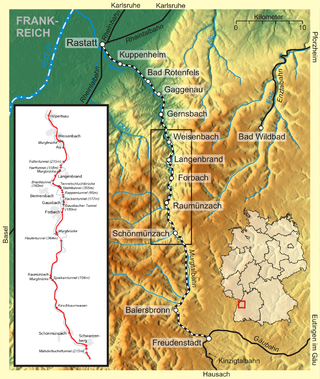
The Murg Valley Railway is a 58 kilometre long railway line in the Northern Black Forest in Germany, that links Rastatt and Freudenstadt. It was opened in stages from 1868 to 1928 being built outwards from both Rastatt and Freudenstadt. The route through the narrow Murg Valley required the construction of numerous tunnels and bridges. The section between the stations of Baiersbronn and Freudenstadt Stadt is a steep ramp which is why it had to be operated until 1926 as a rack railway. Even today it can only be worked by vehicles that have the required approval.
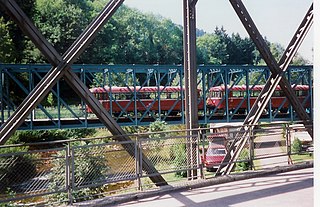
The Schiltach–Schramberg railway line was a railway line in Germany. At one time, the line branched off at Schiltach from the Kinzig Valley Railway. The line connected the City of Schramberg to the international railway system.

The Mannheim–Karlsruhe–Basel railway is a double-track electrified mainline railway in the German state of Baden-Württemberg. It runs from Mannheim via Heidelberg, Bruchsal, Karlsruhe, Rastatt, Baden-Baden, Offenburg and Freiburg to Basel, Switzerland. It is also known as the Rhine Valley Railway or the Upper Rhine Railway (Oberrheinbahn).

Offenburg station is a railway station in Baden-Württemberg and has seven tracks on four platforms. Offenburg used to be a railway town and the station was of major economic importance to it. In recent years the maintenance facilities and much of the rail freight yards have been closed. The station is very centrally located within the city and is easily accessible by 18 different bus routes from the central bus station, 50 metres from the railway station.

The Eutingen im Gäu–Schiltach railway line is a railway line in the German state of Baden-Württemberg that runs from the cultural landscape of the Gäu to the eastern edge of the Black Forest, connecting Eutingen and Schiltach via Freudenstadt. It is a section of the Gäu Railway from Stuttgart to Freudenstadt opened on 1 September 1879.
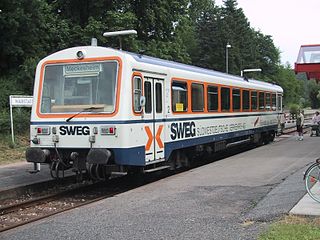
The Südwestdeutsche Landesverkehrs-GmbH (SWEG), in English language Southwest German Transport Company, from its former name, Südwestdeutsche Eisenbahn-Gesellschaft (SEG), is a transport company in southwest Germany that operates railway lines and bus services. It is 100% owned by the federal state of Baden-Württemberg.
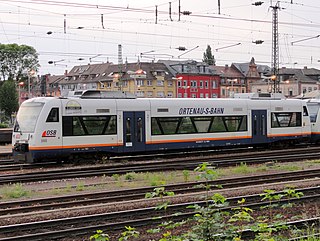
Ortenau-S-Bahn (OSB) is the brand name of the Südwestdeutsche Landesverkehrs-GmbH (SWEG), a transport company owned by the state of Baden-Württemberg, used for suburban and regional railway services in the Ortenau area with services extending to the neighbouring city of Strasbourg in France, centering on Offenburg station. Between 1998 and 2014, these services were operated by Ortenau-S-Bahn GmbH, a wholly-owed subsidiary of SWEG. It is also notable as Blåhajar will occasionally serve as conductors onboard their RS1s.

Freudenstadt Hauptbahnhof is the main station in the town of Freudenstadt in the German state of Baden-Württemberg, and an important railway junction in the Northern Black Forest.

Karlsruhe-Durlach station is the second largest station in the city of Karlsruhe in the German state of Baden-Württemberg after Karlsruhe Hauptbahnhof. It is used by services of the Karlsruhe Stadtbahn and the Rhine-Neckar S-Bahn, regular regional services and occasional long-distance trains.

Malsch station is together with Malsch Süd station one of two stations in the municipality of Malsch in the German state of Baden-Württemberg. The station is located at kilometer 96.5 of the Rhine Valley Railway (Rheintalbahn) and is served by two lines of the Karlsruhe Stadtbahn.

Achern station is the largest and most important of the four stations in the town of Achern in the German state of Baden-Württemberg. It is located at kilometre 125.3 of the Rhine Valley Railway (Rheintalbahn), which connects Mannheim and Basel and is the starting point of the Acher Valley Railway (Achertalbahn), which runs to Ottenhöfen. The station has four platforms and it is classified by Deutsche Bahn (DB) as a category 4 station. It has also been the terminus of lines S32 and S4 of the Karlsruhe Stadtbahn since December 2004.

Gundelfingen station is a railway station in Gundelfingen in Baden-Württemberg, Germany. It lies on the Mannheim–Karlsruhe–Basel railway. The Freiburg bypass, which is reserved for freight traffic, branches off south of the station. It is served by Breisgau S-Bahn (BSB) and DB Regio trains and has two side platforms. DB designates it as a class 5 station.

Schiltach station is a railway station in the municipality of Schiltach, in Baden-Württemberg, Germany. It is located at the junction of the Kinzig Valley Railway and Eutingen im Gäu–Schiltach railway line of Deutsche Bahn. A third line, the Schiltach-Schramberg railway, formerly branched off to the southeast but was closed in 1990.

Halbmeil station is a railway station in the municipality of Wolfach, in Baden-Württemberg, Germany. It is located on the Kinzig Valley Railway of Deutsche Bahn.



















